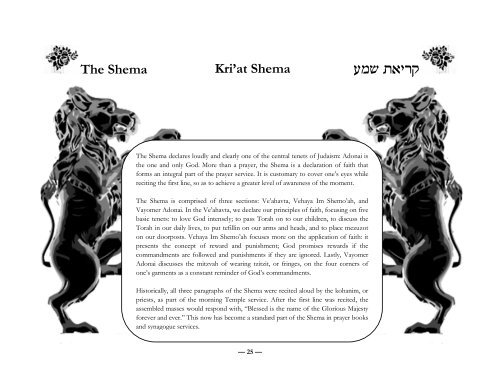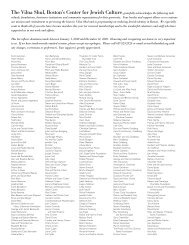Create successful ePaper yourself
Turn your PDF publications into a flip-book with our unique Google optimized e-Paper software.
<strong>The</strong> Shema<br />
קריאת שמע Kri’at Shema<br />
<strong>The</strong> Shema declares loudly and clearly <strong>on</strong>e of <strong>the</strong> central tenets of Judaism: Ad<strong>on</strong>ai is<br />
<strong>the</strong> <strong>on</strong>e and <strong>on</strong>ly God. More than a prayer, <strong>the</strong> Shema is a declarati<strong>on</strong> of faith that<br />
forms an integral part of <strong>the</strong> prayer service. It is customary to cover <strong>on</strong>e’s eyes while<br />
reciting <strong>the</strong> first line, so as to achieve a greater level of awareness of <strong>the</strong> moment.<br />
<strong>The</strong> Shema is comprised of three secti<strong>on</strong>s: Ve’ahavta, Vehaya Im Shemo’ah, and<br />
Vayomer Ad<strong>on</strong>ai. In <strong>the</strong> Ve’ahavta, we declare our principles of faith, focusing <strong>on</strong> five<br />
basic tenets: to love God intensely; to pass Torah <strong>on</strong> to our children, to discuss <strong>the</strong><br />
Torah in our daily lives, to put tefillin <strong>on</strong> our arms and heads, and to place mezuzot<br />
<strong>on</strong> our doorposts. Vehaya Im Shemo’ah focuses more <strong>on</strong> <strong>the</strong> applicati<strong>on</strong> of faith: it<br />
presents <strong>the</strong> c<strong>on</strong>cept of reward and punishment; God promises rewards if <strong>the</strong><br />
commandments are followed and punishments if <strong>the</strong>y are ignored. Lastly, Vayomer<br />
Ad<strong>on</strong>ai discusses <strong>the</strong> mitzvah of wearing tzitzit, or fringes, <strong>on</strong> <strong>the</strong> four corners of<br />
<strong>on</strong>e’s garments as a c<strong>on</strong>stant reminder of God’s commandments.<br />
Historically, all three paragraphs of <strong>the</strong> Shema were recited aloud by <strong>the</strong> kohanim, or<br />
priests, as part of <strong>the</strong> morning Temple service. After <strong>the</strong> first line was recited, <strong>the</strong><br />
assembled masses would resp<strong>on</strong>d with, “Blessed is <strong>the</strong> name of <strong>the</strong> Glorious Majesty<br />
forever and ever.” This now has become a standard part of <strong>the</strong> Shema in prayer books<br />
and synagogue services.<br />
— 25 —




